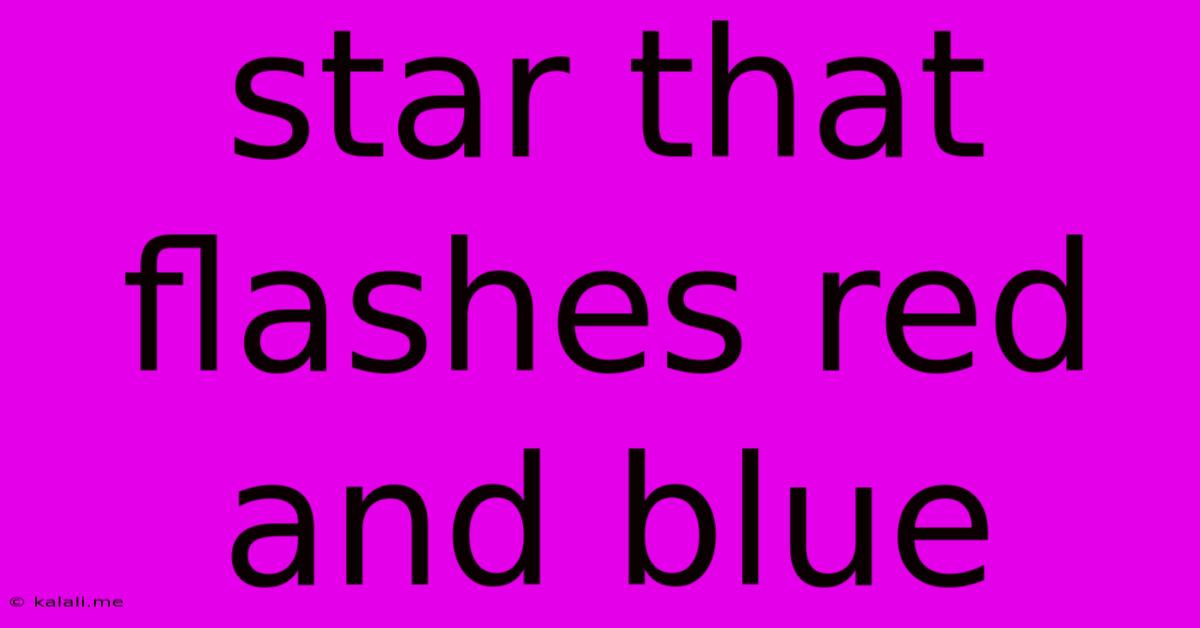Star That Flashes Red And Blue
Kalali
May 24, 2025 · 3 min read

Table of Contents
The Enigmatic Dance of Red and Blue: Understanding Flashing Stars
Have you ever witnessed a star that seems to pulse with alternating red and blue light? This captivating celestial phenomenon might sound like science fiction, but it's a real occurrence, albeit a rare and fascinating one. While not all flashing stars exhibit this specific red and blue interplay, the underlying mechanisms responsible for their flickering nature offer a glimpse into the incredible dynamism of the universe. This article delves into the science behind these twinkling giants, exploring the various reasons why a star might appear to flash red and blue.
What Causes a Star to Appear to Flash?
The apparent flashing of a star is rarely due to the star itself undergoing rapid changes in luminosity. Instead, the effect is usually caused by atmospheric interference or the observer's perspective. Let's break down the most common culprits:
Atmospheric Effects:
-
Atmospheric Refraction: Earth's atmosphere is not uniform. Density variations cause starlight to bend as it passes through, creating a shimmering or twinkling effect. This is especially pronounced when observing stars close to the horizon. The different wavelengths of light (red and blue) are refracted slightly differently, potentially leading to a perceived color shift as the light bends.
-
Turbulence: Air currents in the atmosphere can distort the starlight, causing rapid fluctuations in brightness and apparent color. This is why stars often appear to "twinkle" more on nights with higher atmospheric turbulence. The swirling air masses can momentarily amplify or dampen specific wavelengths, making a star seem to flash red and blue.
-
Clouds and Obstructions: Passing clouds or other atmospheric obstructions can partially block a star's light, creating a flashing effect. While not inherently related to color changes, the quick on-and-off nature can mimic the appearance of a flashing star.
Stellar Phenomena (Less Common):
While atmospheric effects are the most likely explanation, certain stellar phenomena can also contribute to the appearance of flashing:
-
Binary Stars: If a star is part of a binary system, the orbital movement of the two stars might cause periodic eclipses or changes in overall brightness, leading to perceived flashing. If the stars are significantly different in temperature, this might manifest as a red and blue shift in apparent color.
-
Variable Stars: Some stars are inherently variable, meaning their luminosity changes naturally over time. This variability can be caused by pulsations, eruptions, or other intrinsic processes. While not always manifesting as a clear red and blue flash, rapid variability could lead to a perceived flickering effect.
Distinguishing Atmospheric Effects from Stellar Phenomena:
Determining whether the flashing is due to atmospheric conditions or an intrinsic stellar property requires careful observation and potentially advanced astronomical techniques. Several factors can help differentiate:
-
Consistency: If the flashing is consistent over several nights of observation, it's more likely related to the star itself. Atmospheric effects are typically more random and change rapidly.
-
Other Stars: Observe nearby stars. If other stars in the same region of the sky are also exhibiting significant twinkling, the effect is likely atmospheric.
-
Telescopic Observation: High-powered telescopes can help reduce the impact of atmospheric distortion, making it easier to identify whether the flashing is inherent to the star.
Conclusion:
The captivating sight of a star seemingly flashing red and blue is most often a product of Earth's atmosphere. However, the possibility of observing truly variable stars that display this effect remains a fascinating element of astronomical study. Continued observation and advancements in astronomical technology will continue to refine our understanding of these celestial wonders and the dynamics of the stars themselves.
Latest Posts
Latest Posts
-
How Long Does Grout Take To Cure
May 25, 2025
-
Best Early Energy Systems In Skyfactory 4
May 25, 2025
-
Fundamental Group Of The Figure Eight Space
May 25, 2025
-
From The Sevenity Maxims Of Maximally Effecftive Mercenaries
May 25, 2025
-
Can You Put Frozen Meat In A Crock Pot
May 25, 2025
Related Post
Thank you for visiting our website which covers about Star That Flashes Red And Blue . We hope the information provided has been useful to you. Feel free to contact us if you have any questions or need further assistance. See you next time and don't miss to bookmark.